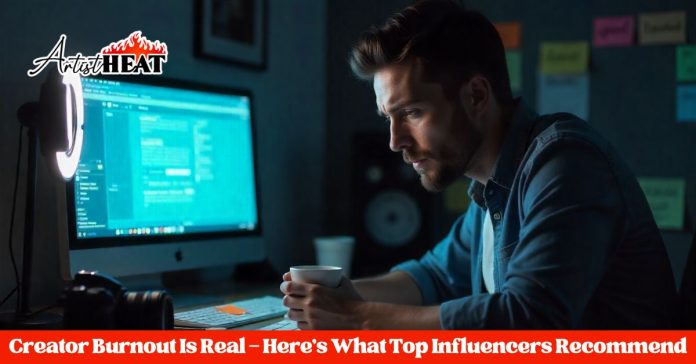Imagine this: you are on your Instagram at 2 am browsing around and watching your favorite creator (most likely their saying sorry) for being “come-up short” and clearly being so tired. Sound familiar? Creator burnout has become the elephant in the room that nobody wants to talk about, but here we are in 2025, and it’s time we got real about it.
It is a world that has changed so much since the early era of YouTube and Instagram. Things that began as humor runabout projects now turned into bona fide companies, along with all the husbandry, demands, and of course the ultimate side-affect of burnout that occurs with any high pressure occupation. But here’s the thing – creator burnout isn’t just about feeling tired after posting a video. It’s a complex web of mental, physical, and creative exhaustion that’s affecting millions of content creators worldwide.
The Reality Check Nobody Asked For
Here is the truth about it, the creator economy isn t just ring lights and brand sponsorship. Behind those carefully crafted feeds and flawless content, there is a world that is a lot more exhausting than most established jobs. Content producers are like one-man media houses with no staff, so they have to produce content, develop business, market, handle customers, and on top of that, often their mental well-being.
An example of the same is Emma Chamberlain. She has been very vocal about the desire to take breaks and how daunting the idea of always producing content may be despite her enormous success. Or Simone Giertz, the inventor and YouTuber that has been vocal on the creative stress and the toll it took on her relationship with working with things that she loved.
The figures are shocking as well. The research conducted recently revealed that the prevalence of burnout in content creators reaches more than 70 percent, and the burnout symptoms resemble those that occurred in high-stress corporate settings. The difference? Majority of creators lacks HR departments, mental health benefits, and the chance to call in sick without their incomes being directly affected.
When Your Passion Becomes Your Prison
The most insidious part of creator burnout is how it creeps up on you. Sometimes you feel enthusiastic about your next video idea, and in another moment, you take a look at your camera asking yourself why something that made you happy before seems as a path to the top of Mount Everest with flip-flops.
Such a transformation occurs since the creator economy relies on the vicious cycle of content generation. The algorithms prefer consistency, the audience requires regular uploads, and fear of being forgotten motivates most creators to overstep healthy limits. The magic dies when you stop being creative and turn into a content mill, and that is where it all originates.
The psychological effect is not imaginary and cannot be measured. A high number of creators say that they simply cannot switch off because their personal lives become content, their hobbies business enterprises and whatever they truly are, brands. It is as though one is in a reality show that has no final episode and each instance is a possible content and each pause a miss opportunity.
The Algorithm Monster and Unrealistic Expectations
Now, this is where things turn spicy, the algorithm does not care that you are in good mental health. No matter whether we say about a fast-paced nature of TikTok, switching monetization policies in YouTube, or changes in the functionality of Instagram, these platforms are not made to focus on the wellbeing of creators; quite the contrary, they are habitually shift to maintain user engagement.
The need to remain relevant has led to many creators always feeling the need to follow every trend, even when it does not make sense with the brand or their interest. This constant adaptation can lead to a loss of creative identity and, ultimately, creator burnout. It is like someone is constantly asking you to rebrand yourself every couple of months and still sound like yourself in the process a task that is extremely difficult giving most individuals great fatigue and loss of control over what they are writing.
And there is comparison trap. Social media gives you the temptation to look in comparison with other people to the highly visible highlights of their own real-life battles. The impression that other creators easily create content compared to when you are struggling may drive a person further towards burnout after making them feel inadequate.
What the Pros Actually Do (Spoiler: It’s Not What You Think)
Now for the good stuff – real advice from creators who’ve been in the trenches and lived to tell the tale. Forget the generic “just take breaks” advice; these are battle-tested strategies from people who’ve navigated creator burnout and come out stronger.
First would be bacht content creation but not how you are imagining it. To avoid a repetitive content creation process which burns you out creatively (usually shooting ten videos in a day), great content creators such as Ali Abdaal recommend batching by energy source. High-energy tasks when you have the energy, think when you have things to think about, and deal with the administration when you are out of ideas.
The other game changer is establishing limits that hold firm. Casey Neistat, verified after taking a break on daily vlogging, has a famous reason to stop vlogging as it was becoming harmful to his family and creative satisfaction. Setting boundaries is one thing and Hilary has nailed that, but being clear to communicate this to your audience and stay on track even when the algorithm gods may not be feeling so good is the other thing.
The Art of Strategic Laziness
This is an idea that could give you an epiphany: strategic laziness. It is not the question of just idling around, it is precisely of what energy you choose to be selective with. The creators such as Marques Brownlee are able to do so by spending more time on fewer but better topics instead of producing daily output.
Such method involves a radical change of mind. This is in lieu of the question, What can I create content-wise today? the question that arises is what is content that is worthy to get an energy best? This mindset helps prevent creator burnout by ensuring that your creative efforts are purposeful rather than just productive.
Strategic laziness has the beauty of resulting in improved material often. You can be creative and innovate when you are not physically too tired to work. Your audience feels the difference as well they can always tell the difference between something produced with purpose rather than duty.
Building Your Creative Life Raft
Recovery from creator burnout isn’t just about rest – it is a process of restoring your bond with creativity itself. It can be translated into finding again that thing that (at the beginning) attracted you to content creation in the first place, before the numbers and ad money made everything look gray through the lens of metrics and monetization.
Most effective creators suggest having a play practice, aka non-monetized and non-publicized creative actions. This may be drawing, journaling in a personal journal, trying new food recipes, or reading to play an instrument. The trick is to reserve a few creative areas and segregate them with your social media articles.
It is also important not to be a creator only. You are a human person with the interests, people are related and have a value regardless of your content. It is by developing these other parts of you that you develop a cushion against the natural fluctuations of the creator economy.
The Future of Sustainable Creating
As we look into the future, the creator economy gradually acknowledges this by sustainable practices. Platforms have already started using functions to aid creator well-being, and viewers themselves are becoming more sympathetic to creators who take care of their mental health.
The most successful creators of 2025 and beyond will be those who learn to create sustainably from the start, rather than waiting for creator burnout to force them into healthier practices. It includes construction of businesses capable of resisting changes in algorithms, creation of content that can satisfy them, and boundaries that guard their wellbeing.
It is not to avert all stress or challenge you see, creativity frequently is boosted by a little pressure. It will be sustainable to achieve a practice that enables you to produce a meaningful content without compromising mental health, the relationships, or fun in the process. Creator burnout is real, but it’s not inevitable. Creative practice should not take life out of you, and with the proper strategies, boundaries and the right frame it can be created. The artists who are successful in the long-term run are not the most gifted and diligent ones but those who can become competent in working with their human shortcomings instead of becoming a slave to them.

